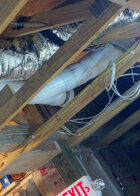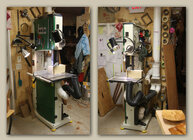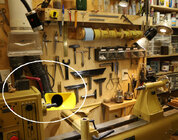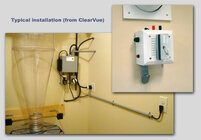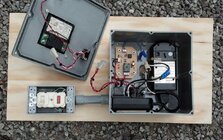Hello,
I have finally gotten to the point where I might get to start using my lathe before it rusts away in the basement. I have used it a few times, and each time it is without any duct control. It sucks...
I have started thinking about requirements, and have hit the wall quickly with what seems like a problematic, nebulous subject for nearly anyone new to any woodworking hobby (I am not new to woodworking at all, nor to using a dust collection system, I'm just new to setting up a dust system). CFM, filtration, PPM, static pressure, low pressure high flow and the opposite. I have a fair amount of knowledge in physics and understand a very few principles of ducting -- minimize turns and use gentle sweeps, big pipe is better than small (maybe?), smooth interior duct surface etc.
My shop is tiny. I have about 300 square feet at the most. This will make things easier on my air filter, but without point collection, that stage of collection is not going to help much when the dust is being shoved right up into my face. So I am focused on point dust collection first. My first project will be to turn a bellmouth, or try some version of Robo's saddle-shaped nozzle do know that much.
I need to serve a mitre saw (first branch), a 14" lathe (second branch), a workbench third (an overhead drop for a 2.5" flex hose for hand tools and benchtop cleanup), and at the other end, another 2.5" drop. Somewhere before that last drop, I may add one more branch for a band saw, but I don't have one yet.
My initial thinking was to run a main trunk; a single section of 4" or 6" ducting across the ceiling, which is 16 linear feet across the room. This trunk will branch off to service each of these areas. My basement shop has a wall between it and the crawlspace, so I am toying with the idea of putting the noisy bits on the other side of the wall, but a little concerned about humidity. I also have a whole-house vac in that exact spot in the crawlspace, but it probably hasn't been used for 20 years, I have no idea how capable it would be, nor how hard it would be to convert it, add a different way of turning it on, and so forth. Doesn't seem worth it, unless someone convinces me that it is.
I can do my own wiring, so I can add service where I want it (there is already an outlet/juice right there for the house vac), by a creating a switched outlet where the switch is on the shop side and the outlet on the crawlspace side, and then just leave the dust collector on. Gotta check the NEC to see if that is kosher; can't see why not, though.
I have done a good bit of drain plumbing here, so I will add cleanouts where appropriate.
I do plan on getting a cyclonic separator.
I also plan on going back and finding other posts here, I know there was a very good one related to air filtration, but I cannot get a handle on the needed CFM for the dust control unit, especially when it comes to lathe collection points.
Here are my initial questions:
I have read that PVC creates static buildup and causes clogs, and probably so does the internal shoulder on PVC fittings. Is this concern overblown? I can work with PVC or metal HVAC ducting. It seems like it would be easier to reconfigure metal ducting and install it so that there are no shoulders, unless I don't use cement on the PVC joints in strategic places.
Should I splurge on 6" ducting, or is that overkill? What other drawbacks would it have over 4" ducting?
How many CFM are needed for my spiffy bellmouth/saddle to effectively remove a reasonable amount of dust? I don't care about the chips in the same way as I care about the sub-5mu particles.
Should I have any concern about using a switched outlet and leaving the collector unit on at all times?
Should I be concerned about crawlspace humidity ruining my equipment? My furnace is down there, and its not rusty, nor is the water heater. I also have plans to get better vapor control in there "soon".
Since I am more focused on the fine dust, which one is better for collecting it: low volume + high pressure, or the opposite?
What else am I missing, or what other pro-tips come to mind?
Thanks in advance
I have finally gotten to the point where I might get to start using my lathe before it rusts away in the basement. I have used it a few times, and each time it is without any duct control. It sucks...
I have started thinking about requirements, and have hit the wall quickly with what seems like a problematic, nebulous subject for nearly anyone new to any woodworking hobby (I am not new to woodworking at all, nor to using a dust collection system, I'm just new to setting up a dust system). CFM, filtration, PPM, static pressure, low pressure high flow and the opposite. I have a fair amount of knowledge in physics and understand a very few principles of ducting -- minimize turns and use gentle sweeps, big pipe is better than small (maybe?), smooth interior duct surface etc.
My shop is tiny. I have about 300 square feet at the most. This will make things easier on my air filter, but without point collection, that stage of collection is not going to help much when the dust is being shoved right up into my face. So I am focused on point dust collection first. My first project will be to turn a bellmouth, or try some version of Robo's saddle-shaped nozzle do know that much.
I need to serve a mitre saw (first branch), a 14" lathe (second branch), a workbench third (an overhead drop for a 2.5" flex hose for hand tools and benchtop cleanup), and at the other end, another 2.5" drop. Somewhere before that last drop, I may add one more branch for a band saw, but I don't have one yet.
My initial thinking was to run a main trunk; a single section of 4" or 6" ducting across the ceiling, which is 16 linear feet across the room. This trunk will branch off to service each of these areas. My basement shop has a wall between it and the crawlspace, so I am toying with the idea of putting the noisy bits on the other side of the wall, but a little concerned about humidity. I also have a whole-house vac in that exact spot in the crawlspace, but it probably hasn't been used for 20 years, I have no idea how capable it would be, nor how hard it would be to convert it, add a different way of turning it on, and so forth. Doesn't seem worth it, unless someone convinces me that it is.
I can do my own wiring, so I can add service where I want it (there is already an outlet/juice right there for the house vac), by a creating a switched outlet where the switch is on the shop side and the outlet on the crawlspace side, and then just leave the dust collector on. Gotta check the NEC to see if that is kosher; can't see why not, though.
I have done a good bit of drain plumbing here, so I will add cleanouts where appropriate.
I do plan on getting a cyclonic separator.
I also plan on going back and finding other posts here, I know there was a very good one related to air filtration, but I cannot get a handle on the needed CFM for the dust control unit, especially when it comes to lathe collection points.
Here are my initial questions:
I have read that PVC creates static buildup and causes clogs, and probably so does the internal shoulder on PVC fittings. Is this concern overblown? I can work with PVC or metal HVAC ducting. It seems like it would be easier to reconfigure metal ducting and install it so that there are no shoulders, unless I don't use cement on the PVC joints in strategic places.
Should I splurge on 6" ducting, or is that overkill? What other drawbacks would it have over 4" ducting?
How many CFM are needed for my spiffy bellmouth/saddle to effectively remove a reasonable amount of dust? I don't care about the chips in the same way as I care about the sub-5mu particles.
Should I have any concern about using a switched outlet and leaving the collector unit on at all times?
Should I be concerned about crawlspace humidity ruining my equipment? My furnace is down there, and its not rusty, nor is the water heater. I also have plans to get better vapor control in there "soon".
Since I am more focused on the fine dust, which one is better for collecting it: low volume + high pressure, or the opposite?
What else am I missing, or what other pro-tips come to mind?
Thanks in advance

